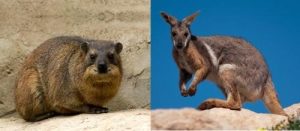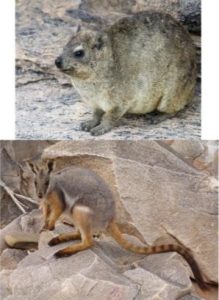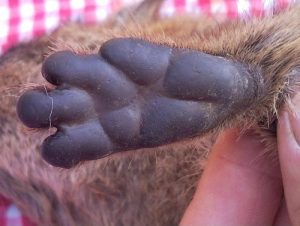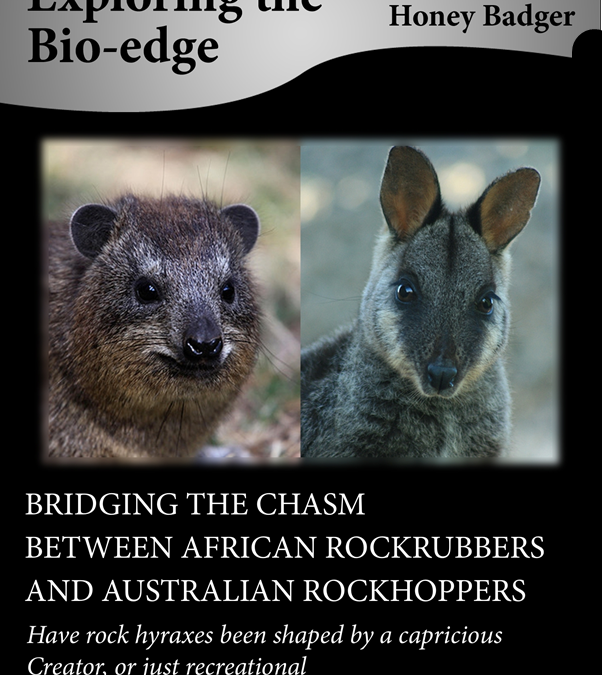Have rock hyraxes been shaped by a capricious Creator, or just recreational killing by baboons?
Consider the pros and cons of being a rock-dwelling mammal. One pro is that boulder outcrops are abundant, so there is ample real estate. Indeed, such outcrops look similar wherever in the world we find certain combinations of geology and erosion, with granitic rocks being particularly widespread and their domed exposures being particularly uniform across all continents. Another apparent pro is that crevices in rocks provide shelter from weather and predators. On the con side, bare rock is both a barrier to locomotion and a potential deadfall, making adaptations of the limbs a matter of gravity. A single rock-dwelling life-form should in principle be suited to the similar boulder outcrops on all continents besides Antarctica.
Although no rock-dwelling species spans the continents, we would at least expect the mammals intimately adapted to these similar environments to converge into similar shapes by the forces of nature, regardless of their ancestries. Yet, as typical denizens of the boulders, the rock hyraxes of Africa and the Middle East are so different from the rock-wallabies of Australia (see Figure 1) that the concept of ‘convergent evolution’’ seems to have fallen off a cliff. Our leap of faith in this blog-post is that perhaps the puzzle of cause and effect would be solved by a more determined search for environmental differences between the continents.


Figure 1. Yellow-spotted rock hyrax (Heterohyrax brucei) and brush-tailed rock-wallaby (Petrogale penicillata), showing comparative portraits [photos by John Dalkin and Melissa Doherty, respectively].
Rock hyraxes resemble rodents in only the most superficial of ways and are complicated to describe because they are not particularly similar to any other group of mammals. For example, the hyraxes are said to share anatomical features with their distant relatives, elephants, but we have found these to be too nebulous even to summarise here. Instead, we find that rock hyraxes actually have similar cheek-teeth to rhinoceroses. For their part, rock-wallabies are relatively easy to characterise, being essentially miniature versions of kangaroos that somehow maintain bipedal hopping on the most uneven of terrain (see Figure 2). And it is the wallabies – in common with most other members of the kangaroo family – that have cheek-teeth somewhat convergent with those of elephants.


Figure 2. Rock hyrax (Procavia capensis) and yellow-footed rock-wallaby (Petrogale xanthopus), showing that, in normal postures, rock-wallabies do not place their forepaws on the substrate [photos by Barry Lloyd and Adam Jenkins respectively].
Not only do the body proportions of rock hyraxes and rock-wallabies diverge, but even the internal organs differ so much that these two groups of mammals seem as disparate as igneous and sedimentary rocks. Although there may be a bedrock of similarities between the hyraxes and the wallabies in terms of mass, relatively slow metabolism and growth, and limited brain size, these hardly add up to any overall evolutionary convergence. This is a problem for biologists, because it casts doubt on the validity of the whole idea that adaptation – as opposed to a capricious Creator – is the shaping force of Life.
Equally perplexing are the differences between hyraxes and various other climbing mammals. Unlike most climbers, rock hyraxes lack not only any claw or nail capable of gripping the substrate, but also any thumb or big toe. Rock-wallabies are also odd among climbers because they retain the hopping locomotion of their plains relatives with only minor modifications for negotiating the rocks, such as the bluntness of the hind claw. Because rock-wallabies retain not only the leg proportions but also the reproductive pouch and conveyor-belt dentition of other wallabies and kangaroos, it seems as if the wallabies of flat terrain have evolved into rock-wallabies with superficial and behavioural modification rather than profound, physiological changes.
These disparities between rock hyraxes and rock-wallabies seem all the more puzzling when we consider that both are eaten by similar eagles, African black eagle in the case of the hyraxes and the wedge-tailed eagle in the case of the wallabies. Why has culling by avian predators through time not shaped their rock-dwelling, rabbit-size mammalian prey into forms more similar than we find in reality?
Our new explanation is that boulder outcrops in Africa and the Middle East are generally far more beset by mammalian predation than are boulder outcrops in Australia. And that, as a result, the adaptive differences between rock hyraxes and rock-wallabies ultimately make sense as appropriate evolution – as opposed to reflecting some sort of fault-line in the natural order. This explanation is supported by the fact that boulder outcrops in Africa and the Middle East are home to leopard, caracal, honey badger, and other Carnivora whereas Australia is lacking in precise counterparts. Even the recently extinct thylacine and the more remotely extinct ‘marsupial lion’ were not associated with boulder outcrops, and there is certainly no suggestion of the marsupial lion having been particularly predatory on wallabies.
On the other hand, rock hyraxes are exposed to a wide range of predators. It appears, for example, that where particularly dense populations of predators occur, the hyraxes – despite their apparent inaccessibility – can be locally exterminated. Such is the case in the southern parts of the Kruger National Park, where extensive granite boulder outcrops in the areas most heavily populated by the leopard are strangely devoid of the hyraxes so taken for granted in similar terrain over much of South Africa. Although a felid is the likely culprit in this particular example, our chief suspects for the predator that has had the greatest influence on the evolution of rock hyraxes are baboons: large omnivorous monkeys that congregate on boulder outcrops to sleep at night after foraging on surrounding plains by day. These primates, although not carnivorous, match or exceed the rock-scaling abilities of the hyraxes and are consequently in a position to kill them. Given that baboons are known occasionally to kill the infants of savanna antelopes as well as adult cane rats, which are similar in size to hyraxes, there is the possibility of a subtle, previously overlooked selective pressure on the hyraxes. By contrast, the original mammal fauna of Australia – perhaps fortunately for rock-wallabies – lacks any mammals resembling primates, least of all baboons.
Indeed, baboons have no climbing peers of equivalent body size in Australia, past or present, whereas in Africa there must have been very few boulder outcrops where rock hyraxes would have been free of baboons as co-tenants and part-time predators. Although few observations have been made, we can visualise from our perspective here at the Bio-edge that what appears to be a cosy sharing of refuges is in reality a taxing relationship on the smaller-brained mammals, particularly because of the intelligence and teamwork of baboons. We refer especially to the mischievous and destructive juvenile males, which may behave like council block or tenement gangsters towards the hyraxes. Even as only occasional, opportunistic killers, and even if they harm the hyraxes with wanton calculation rather than being motivated by hunger, baboons are in a position to inflict hypothetical losses because of their sheer numbers and the fact that each evening and each morning, bored by the temporary lethargy of the group or bullied in its hierarchy, they may find themselves among – what is to them – the closest thing to food, toys, or soft targets: namely rock hyraxes.
So, let us make a more detailed comparison to see if predation explains why what we might call the rockrubbers of Africa and the Middle East are not mirrored by our rockhoppers of Australia. We consider hiding, alarming, escaping, defending, and reproducing.
Hiding is a way in which prey species can be adapted to evade pressure from predators. Rock hyraxes hide more effectively than rock-wallabies do, spending all night within crevices into which they can jamb their long, low bodies, and foraging as rapidly as possible in the immediate vicinity of their refuges. Furthermore, the hyraxes lack tails whereas the wallabies have extremely long tails (see Figure 3). Being tailless is likely to serve the hyraxes, huddled deep in crevices, by denying baboons and other enemies any easy grasp on their bodies. And, although the hyraxes forage in the mornings and evenings, this does not pose a risk from baboons, which forage away from the boulder outcrops in daylight, and are therefore likely to be kilometres away at these times. So the hyraxes may be hiding not only in space but also in time from baboons.


Figure 3. Rock hyrax and yellow-footed wallaby, showing the taillessness of the hyraxes and the extremely long tail of the wallabies [photo of rock hyrax by Johann du Preez].
When the hyraxes do venture away from their rock cover, rapid foraging is aided by features of their teeth and guts. Their cheek-teeth differ from those of the wallabies in having such sharp edges that it is the premolars, instead of the incisors, that are used to detach and chew food. At the same time, the premolars and molars occlude precisely – compared with those of rock-wallabies – and therefore chew efficiently with a few quick strokes of the jaws. This emphasis on hasty foraging and hiding may help to explain why the stomachs and intestines of the hyraxes are quite different from those of the wallabies and bear no resemblance to their distant relatives, elephants or rhinoceroses. Although both rock hyraxes and rock-wallabies have gut compartments that make the most from the limited amount of food found within reach of boulder outcrops, the hyraxes have an arrangement unique among mammals: two stomachs with the second one located partway down the intestine. The wallabies, by contrast, have their stomach in the location and form expected for members of the kangaroo family: a large colon-like sac in which food ferments before entering the intestines. Our interpretation of this difference is that rock hyraxes use the first stomach partly for storage of hastily harvested material, reserving the second one for digestion. Rock-wallabies, by contrast, usually forage by night in the relative safety of a land with few predators, chew their food in relative leisure, and need no particular chamber for storing food.
Alarming is a second way in which prey species can be adapted to pressure from predators. Rock hyraxes have really given voice to this tactic. They are not only extremely vocal in announcing the appearance of predators but also have a wide range of alarm calls for different types of predator spotted: a whistle for eagles, a grunt for snakes, and a loud or soft squeal for mammals. Indeed, their vocal versatility of as many as 20 different sounds – considering the modest level of brain development of the hyraxes – is impressive among mammals. Somewhat ironically, this complexity seems to exceed that of baboons, which have relatively simple utterances despite their intelligence. And to add insult to insult, the hyraxes go one step further than mere communication amongst their group; using soft calls to alert the whole family group with the acoustic advantages of rock walls, and issuing alarm calls loud enough to inform the predator itself that it has lost the element of surprise. In contrast to the vocal heights reached by hyraxes, rock-wallabies are quiet; we have not heard of any sounds of alarm made by them other than perhaps an initial thumping of the hind feet when fleeing.
Escaping is a third way in which prey species can be adapted to pressure from predators. Again, rock hyraxes are escape artists, using all four of their legs to flee, whereas rock-wallabies seem strangely clunky by comparison, fleeing on their hindlimbs. In their clumsiness the wallabies appear to be concerned more with conserving energy through limb economy than are the hyraxes – with the prime advantage to the hyraxes being sure-footedness as they dash across and among rocks. This is not surprising given that the fleeing gaits used by mammals tend to show a compromise between efficiency and stability. The wallabies seem to be designed primarily around the concept of efficiency; whether ascending or descending, they minimise contact with the substrate when moving at maximum speed by hopping bipedally and whipping the long tail for balance as they negotiate the boulders. This possibly gives them an advantage in fuel-economy because their bounce recycles energy in the ankle tendons. Rock hyraxes, on the other hand, seem to be designed primarily around the concept of life or death. For the hyraxes, bouncing would likely be a false economy in the tight dodging necessary when outmanoeuvring either a hungry leopard or a wanton thuggery of baboons. A visualisation of our rockrubbers and rockhoppers in such a scenario may show that it is the wallabies that are more likely to misstep in full flight.
But rock hyraxes do not only use all four feet; each foot is specialised for escaping in its own right. For a start, their feet are particularly adapted to uneven surfaces – even compared to their quadrupedal predators. This is because escaping in broken terrain requires more than just the stability of a quadrupedal body form. Accordingly, the hyraxes grip the boulders by means of the bare, smooth, rubbery surfaces of their paws. Although these surfaces are extremely pliable, they are also, by virtue of the protein keratin, counterintuitively tough. This is evident in the fact that the regurgitated pellets of eagles and the faeces of leopards still contain the recognisable soles of rock hyraxes that they have eaten, as intact as the indigestible hooves of any small antelope in the diet of these predators.
The rock hyraxes have yet an extra trick down their sleeves, as it were, because the rubbery adhesiveness of their durable palms and soles is partly owing to their clamminess, and their clinging to the rock surface is a subtle form of suction-cupping (see Figure 4). Long claws would impede such suctioning and accordingly the stumpy digits of the hyraxes have short, blunt nails except for one grooming claw on each hind paw. To promote the suctioning, the paws perspire despite an inability to sweat elsewhere on the body. The result appears to be just enough traction on the rocks to gain an advantage over pursuing predators, which have dry, leathery surfaces lacking the same adhesive quality. But the effectiveness of this anti-predator tactic does come at a considerable cost of body water, given that rock hyraxes usually have limited access to pools or succulent food and often forgo drinking altogether in the interests of retaining a permanent refuge in what is often a dry environment.


Figure 4. Rock hyrax, showing that the anatomy of the palm of the left forepaw can produce a suction-cupping effect [photo by Arikk under the Creative Commons Attribution-Share Alike 3.0 Unported licence].
Escaping is also aided by specialisations in the skeletal structure of the limbs of our rockrubbers, the rock hyraxes. Unlike either their mammalian predators or rock-wallabies, the hyraxes completely lack collar bones, and their wrist and ankle bones swivel to retain contact with rock surfaces whatever the angles of the legs. This contrasts with the wallabies, which do not use the wrists while fleeing and have tightly connected ankle bones that allow each Achilles’ tendon to act as a spring. While the wrist bones of the hyraxes are particularly adept at swivelling, those of rock-wallabies are no more able to swivel than our own. The result of the peculiar anatomy of their ankles and wrists is that the hyraxes can easily keep contact between their paws and the rockiest of terrain where even the most acrobatic baboon would be slightly delayed. To understand the complexity that has made the hyraxes difficult to describe in the past, it may help to imagine a small, rubber-tyred, four wheel-driven vehicle with each wheel mounted on its own swivel and capable of keeping tread on a road buckled by an earthquake.
Defending is a fourth way in which prey species can be adapted to pressure from predators. True to form, rock hyraxes are better equipped than rock-wallabies to bite back. The second incisors of the hyraxes serve as tusks, which – except for the occasional stripping of bark when normal foods are unavailable – are reserved for self-defence. These weapons of defence are kept sharp by honing the edges of the upper and lower incisors against each other, paralleling a defence mechanism in their likely enemies: male baboons, which hone their upper canines against the first lower premolars. The results of this sharpening are well advertised in both prey and potential predator: with both rock hyraxes and male baboons frequently yawning to show off the intact, sharp edges of their front teeth. And unlike either rock-wallabies or baboons, even the premolars of the hyraxes remain sharp enough potentially to complement the tusks in a desperate bite. This is suggested by the fact that, particularly when agitated by a predator, rock hyraxes noisily grind their empty jaws, which simultaneously sharpens the premolars and is likely to remind intelligent adversaries that front teeth and cheek-teeth alike are kept sharp for self-defence.
A fact suggesting the authenticity of their biting threat is that the temporalis muscle is proportionately far larger in rock hyraxes than in most herbivorous mammals. This muscle tends to drive powerful puncturing bites, whereas another jaw muscle, the masseter, tends to be responsible for the routine grinding of food and is massive in even the most harmless of herbivores. It seems that not only do the hyraxes have upper incisors used exclusively on adversaries such as baboons, and premolars capable of partial use on such adversaries, but they also have particularly well-developed muscles driving such bites.
Unsurprisingly, the defences of rock-wallabies are, by contrast, unremarkable. The premolars, which are used like millstones rather than with shear-precision, are likely to be blunter than those of rock hyraxes, and therefore less versatile in self-defence. And the cheek-teeth, like those of kangaroos, emerge throughout adult life as if on a conveyor belt, with the grinding surfaces wearing away at the front of the row and being replaced at the back of the row. Even the front teeth of wallabies lack a sharpening mechanism and are used mainly to detach food. And, in further support of the wallabies not being particularly powerful biters, their temporalis muscle appears to be modest in size.
Reproducing is the fifth and final way in which prey species can be adapted to pressure from predators. And when we compare the reproductive modes of rock hyraxes and rock-wallabies, we find them categorically different, like – to use another geological metaphor – dolomite and dolerite.
If the eutherian mode of reproduction is generally more protective than the marsupial mode against predation, then the gestation of rock hyraxes is particularly indicative of the threat of enemies such as baboons as well as wild felids of various sizes. Rock hyraxes protect their offspring in the womb far longer than do rock-wallabies, their gestation period being seven months which is remarkably long for a mammal of its size. By contrast, the gestation of the wallabies is remarkably short at one month. In fact, believe it or not, the hyraxes gestate as long as the hippopotamus does, whereas the wallabies gestate more briefly than some rats. The result is that the newborn hyraxes weigh about 200 grams, so well-developed that they look like miniature adults; and by contrast, newborn rock-wallabies can be described as mere embryos, weighing only about one gram when transferred to the pouch. Considering that usually three share the womb in the hyraxes whereas only one is born at a time in the wallabies, the result is a roughly 600-fold difference in the total mass of offspring delivered at each birth.
Although rock hyraxes are not particularly protective of their suckling offspring, rock-wallabies – assuming that they behave like similar marsupials – renege to an extraordinary degree on parental care by mammalian standards. Mothers of kangaroos and wallabies tend to jettison their young when chased. This is done by the mother releasing the sphincter of the pouch instead of tightening it. Even if the jettisoned juvenile is not snatched up by the predator and survives its rough tumble of betrayal, it is consistently rejected by its mother, barred from the pouch, and abandoned to die of neglect anyway. According to our interpretation, this amounts to something more than non-gestation: a kind of anti-gestation in which young are actually sacrificed in attempted appeasement of a predator that threatens the mother. This tactic may make sense where threats from predators are relatively infrequent. However, were rock hyraxes to ‘spend a baby’ each time they were harassed by baboons or other predators, they would be sabotaging the survival of the species.
One way to test the idea that African mammals about the size of rock hyraxes are shaped primarily by predation is by examining the one lineage of hopping mammals that does occur in Africa. One would expect such mammals to have particularly secure environments, or to compensate for their gaits in other ways, or both. The purely African springhares provide such a test: they resemble hyraxes and small wallabies in body masses and are as committed to fleeing on their hind legs as the wallabies are. And indeed we find that the fast-growing springhares have a reproductive mode extremely different from that of rock-wallabies, supporting the idea that long gestation and extended periods of hiding the juveniles serves prey species in reproducing successfully in the face of predation.
Our examination may have answered questions about rock hyraxes but it raises the deeper questions of why baboons evolved in Africa in the first place and why no primate-like mammals evolved in Australia. Nevertheless, the non-convergence between the African and Australian animals may not be quite the rub it first seems to be. In terms of environmental cause and adaptive effect, we can speculate that our rockrubbers may be to our rockhoppers as metamorphic rocks are to sedimentary rocks. For adaptation in Africa may have been tempered by the greater heat and pressure of a more hectic history than applies to the Australian animals, rather than simply originating in materials so different that the crystalline structure of their DNA is incomparable. The history of rock hyraxes is likely to have been particularly hectic, with this small mammal having been under the gun from recreational culling by baboons and professional culling by both felids and eagles for as many millions of years as it has taken us to evolve from ape to human.
Acknowledgments:
Our sincere thanks to Sebastien Banuls and Melissa Doherty for permission to use the photos of rock hyrax and rock-wallaby, respectively, on the front cover.
***
All text and images appearing in this blog are subject to copyright, except those images explicitly stated to be in the public domain. You are not free to use any photographs, for any purpose, without receiving written permission from the copyright holder.

